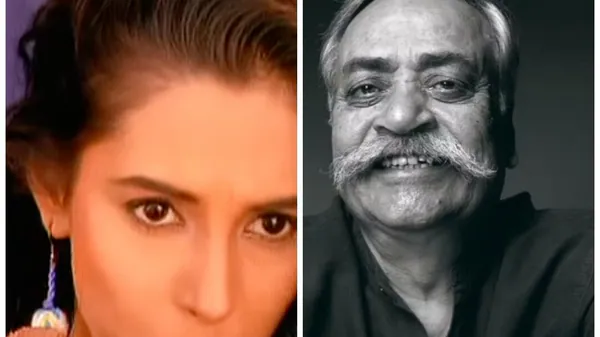
How Piyush Pandey Discovered Cadbury Girl Shimona Rashi Who Went Viral Before 'Viral' Existed
From Fevicol's“Jor laga ke haisha” to Asian Paints'“Har ghar kuch kehta hai”, Pandey turned ad campaigns into cultural milestones.
But among his many classics, one campaign stands apart, a young woman dancing across a cricket field in uninhibited joy, chocolate bar still in hand.
Also Read | Piyush Pandey: The man who gave India its most unforgettable adsThat 1994 Cadbury Dairy Milk commercial didn't just sell a product; it changed how India saw itself, and its chocolate.
The Challenge: How To Make Chocolate 'Adult'By the early 1990s, Cadbury was battling a perception problem. Chocolate was for kids, not for grown-ups.
Ogilvy's brief was deceptively simple: make Cadbury aspirational for adults without losing its innocence.
Pandey, who was then on a Diwali break in the US, was urgently called back to save the account. On the flight home, somewhere over the Atlantic, he began scribbling a few lines on his boarding pass, words that would later become a jingle:“There's something so real in everyone...”
Also Read | Ab ki baar, Modi sarkar: Piyush Pandey almost said no to campaign-what changed?That instinctive note became the emotional spine of a campaign that made advertising history.
The Tune That Came Together OvernightBack in Mumbai, Pandey roped in jazz legend Louis Banks, who composed the melody in minutes before catching his next flight.
Singer Gary Lawyer lent his voice to the English version, but Pandey felt the tune needed a local soul. He rewrote the lyrics in Hindi, keeping Banks' rhythm and brought in Shankar Mahadevan to record the new track.
Mahadevan's improvisation on the line“Kuch swaad hai...” added a warmth that turned the jingle into an emotion, a sound that would echo across India for decades.
The Girl Who Danced Into India's MemoryThe final piece of the puzzle was the protagonist, someone who embodied unfiltered happiness. Pandey didn't want a trained actor or choreographed dancer. He wanted spontaneity.
That's how Shimona Rashi entered the picture. She wasn't a professional performer, but her natural, unrehearsed energy was exactly what the team wanted.
Also Read | RIP Piyush Pandey: Tributes pour in advertising legend passes awayDirector Mahesh Mathai shot the sequence at Mumbai's Brabourne Stadium in one take. Shimona's free-spirited dance, leaping past security guards after a winning cricket shot, became the heartbeat of the campaign.
The tagline“Asli swaad zindagi ka” captured the emotion: joy, as real as it gets.
The Ad That Redefined A BrandWhen the Cadbury girl hit Indian television screens, she instantly became part of pop culture.
For a generation, that 45-second clip symbolised a new kind of India: one that is more confident, spontaneous and comfortable expressing joy in public.
“The campaign changed how Cadbury was consumed,” said Prakash Nair, Associate President at Ogilvy.
“It transformed chocolate from a parent-to-child gift into something that adults could claim for themselves.”
The ad went on to win multiple awards, including Campaign of the Century at the Abbys. But its real victory was cultural: it made indulgence aspirational, not childish.
Shimona Rashi's tweetReacting to sudden passing of adman Piyush Pandey, Rashi wrote on X,“Heartbroken over Piyush Pandey's passing today. His genius wove nostalgia and India's soul into timeless tales-from Cadbury's sweet joys and Fevicol's unbreakable laughs to Asian Paints' heartfelt homes and Vodafone's pug magic. Forever grateful, legend. Rest in peace.#PiyushPanday.”
Legacy, ReimaginedIn 2020, Ogilvy revisited the idea with a gender-reversed version; this time, a man ran onto the field as a woman hit the winning shot.
Pandey gave the project his blessing with one creative non-negotiable:
“Change everything if you want - just don't touch the music.”
Even three decades later, that melody, written on a boarding pass and brought to life by an untrained dancer, remains instantly recognisable.
Why It Still MattersThe Cadbury girl campaign wasn't just about selling chocolate; it was about selling feeling.
In today's data-driven ad world, where virality is engineered, Pandey's 1994 classic remains a reminder that true connection is instinctive - not algorithmic.
He didn't chase trends. He created moments that outlived them.
Legal Disclaimer:
MENAFN provides the
information “as is” without warranty of any kind. We do not accept
any responsibility or liability for the accuracy, content, images,
videos, licenses, completeness, legality, or reliability of the information
contained in this article. If you have any complaints or copyright
issues related to this article, kindly contact the provider above.


















Comments
No comment